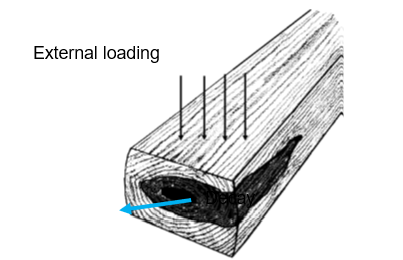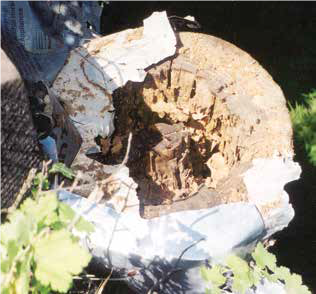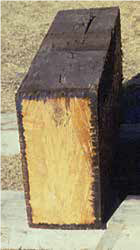Bridge - Visual Inspection
Target of investigations
Visual inspection is beneficial in identifying wood defects such as intermediate and advanced stages of decay, water damage, modified members, mechanical damage, and failed members. Examples of common defects are briefly as follows:
Fruiting bodies
The presence of fruiting bodies, a positive indication of fungal attack, can indicate substantial decay in wood members. While some fungi species generate fruiting bodies after a minor decay, others may produce fruiting bodies after a substantial decay level. Fruiting bodies can be developed when the untreated wood grains are exposed to water [1].

Surface depressions/ sunken surface or localized collapse
The presence of surface depressions can indicate the internal decay of wood members. Decay can generate voids or pockets near the surface of wood, leaving a thin intact/partially intact layer at the surface [1]. As a result of loss in strength and load-bearing capacity, the surface of decayed members may sink when subjected to external loading. Furthermore, the localized crush of a member can indicate a substantial decay [1].

Figure 2. A scenario leading to the surface depressions of a wood member [1].
Staining and discoloration
Staining and discoloration of wood indicate water exposure, and potentially high-moisture areas favorable for decay. The rust stains from metal fasteners can also indicate high-moisture areas due to wetting [1].
Insect activity
The presence of holes, wood powder (frass), and insects can indicate wood damage due to insect activity. Decay can make wood attractive to insects such as carpenter ants [1].

Figure 3. Damage to a wood pile by carpenter ants [1]. The member was initially deteriorated by decay, which attracted carpenter ants.
Plant and moss growth
Plant/Moss growth in the checks and splits of wood members can indicate high moisture levels for a sustained period. Such conditions support fungal decay [1].
Missing members
Missing members refer to the conditions where part or entire structural members are removed [1].
Splits and checks
Splits and checks can indicate a weakened member. While the depth of checks varies, splits extend through a member cross-section. These defects of sufficient depth can lead to the deterioration of the inner untreated section of a member through absorbing moisture and subsequent fungal decay.

Figure 4. Photo. Large timber member treated with preservatives, which have only penetrated a certain depth of the member (darker color).(1)
Alterations
Alterations/modifications of structural members can weaken wood members.1
Description
Visual inspection is the simplest and most commonly used method for evaluating the wood condition. It requires a sufficient light source and is useful for detecting intermediate or advanced surface decay, water damage, mechanical damage, or failed members. During visual inspection, an inspector looks for evidence of decay or damage to wood members, noting areas that require further investigation.
Physical Principle
For visual inspection, sufficient light needs to be reflected from the objects to an inspector’s eyes.
Data Acquisition
As a part of visual inspection, an inspector may perform routine and in-depth inspections. The routine inspection involves reviewing previous reports and visually inspecting members from beneath a bridge, locating obvious decay and damage. On the other hand, indepth inspections require a closer look at one or several members to identify defects that cannot be easily detected during a routine inspection. During the indepth inspection, a hands-on inspection may be performed. Bridge members may be inspected from distances less than an arm’s length away. Visual inspection may be accompanied by other nondestructive evaluation technologies to quantify the extent of the defects.2>
Data Processing
No data processing is required
Data Interpretation
To identify the potential source of decay, an inspector compares the defects in the field with known types of defects (e.g., target of investigation section).
Advantages
Advantages of visual inspection include the following:
- Rapid and well-established field inspection technique
- Simple
- Low cost
Limitations
Some of the limitations of visual inspection include the following:
- Sufficient light and experience is required.
- Identification of decay is difficult at early stages when remedial treatments can be effective to prolong the service life of a member.(1)
- Quantitative information about the mechanical and physical properties of members is not provided.
References
1. White, R. H., and R. J. Ross, eds. 2014. Wood and Timber Condition Assessment Manual. 2nd ed. General Technical Report No. FPL-GTR-234. Madison, WI: U.S. Department of Agriculture, Forest Service, Forest Products Laboratory.
2. Ryan, T. W., J. E. Mann, and Z. M. Chill, and B. T. Ott. 2012. FHWA Bridge Inspector’s Reference Manual (BIRM). Publication No. FHWA NHI 12-049. Washington, DC: Federal Highway Administration. https://www.fhwa.dot.gov/bridge/nbis/pubs/nhi12049.pdf, last accessed February 3, 2022.




